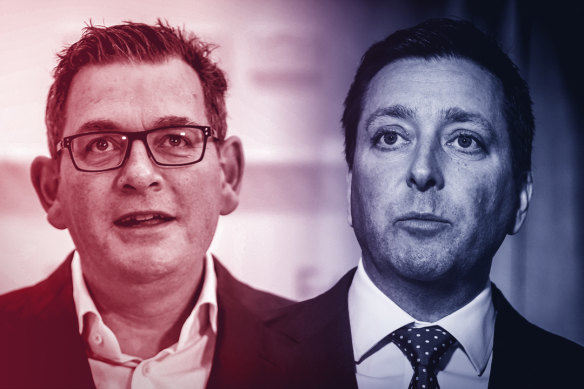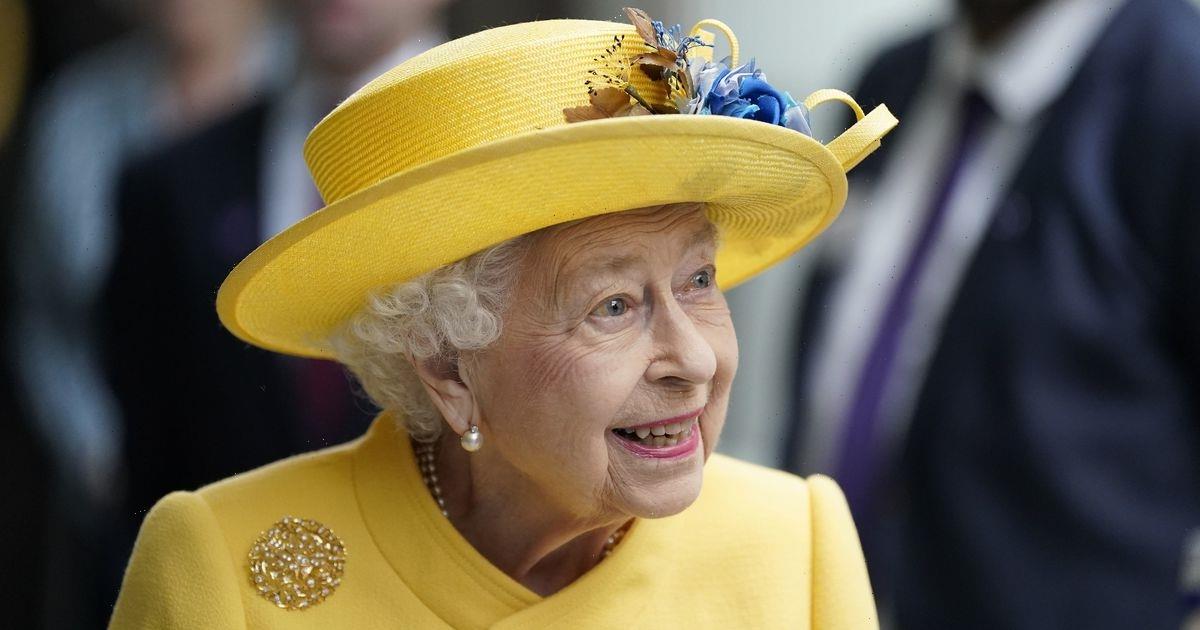Premier Daniel Andrews is on track for another crushing election victory with a survey showing voters will abandon the Liberal Party fearing a change of government in the face of a crumbling healthcare system and skyrocketing living costs.
Labor’s primary vote is at 42 per cent, just 1 percentage point lower than it was at the “Danslide” victory of four years ago, while the Liberals’ primary has plummeted to a new low of 28 per cent, down seven percentage points since 2018 when the Coalition lost a swag of blue-ribbon seats.
The survey shows Daniel Andrews has a commanding lead over Matthew Guy.Credit:The Age
The results in the Resolve Political Monitor, conducted for The Age by research company Resolve Strategic, shows Andrews leads Opposition Leader Matthew Guy as preferred premier by 46 to 28 per cent, compared with a slimmer margin of 48 to 31 per cent in February.
When Guy wrested the Liberal leadership from Michael O’Brien in September last year, Andrews was leading O’Brien as preferred premier 50 to 24 per cent. Guy narrowed the gap in those early days with Andrews ahead at 45 to 32 per cent, but the gap has since widened.
The shift towards Labor is a result of voters’ views on Andrews, according to Resolve Strategic director Jim Reed. Respondents who backed Labor said while they had reservations about the premier, they did not trust the Liberals at all. They see Andrews as “the best of a bad bunch”, believe the government handled the pandemic well and would rather “stick to the devil you know”.
Voters who were against Labor did not reference Guy in their responses, instead saying that Victoria needed “to get rid of Daniel Andrews and his corrupt party”, that the government’s COVID-19 lockdowns had caused “irrevocable” damage to businesses and that Andrews was deceitful.
Reed said there was a “federal overhang” at play, with damage to the Liberal brand as a result of integrity issues further reducing Guy’s chances on November 26.
“It’s an election-winning lead for Andrews and Labor right now, and we might even see a swing to them,” Reed said.
”There’s been a flow of primary votes from the Coalition to Labor of about 5 points since we last surveyed Victorians in February and March. People are locking in behind Labor and leaving the Coalition. Voters seem to be voting for or against Andrews, but any protest vote against the premier is splintering between the Coalition, independents and Greens.”
Twelve per cent of voters have indicated they back the Greens, up 1 per centage point from the last election, while a further 12 per cent said they would vote for an independent, up six percentage points. The poll does not break down the independent votes in individual seats where high-profile candidates, including “teals”, are expected to run, but Reed said he expected the independent vote to slip closer to election day.
Senior Labor figures believe the race is much tighter. In the lead-up to the 2010 state election, public polls gave the then-Labor government a similarly commanding majority, but Labor ended up losing in a surprise twist.
Reed said that this time around people fear changing the government, particularly in light of the issues in the healthcare system and rising cost-of-living pressures. Almost a third of voters said they expected their personal circumstances to worsen, up 10 percentage points since May last year.
”With voters becoming more pessimistic about the future, they’re looking to the safety of a known quantity in the Andrews Labor government,” Reed said. “Regardless of all its flaws, a change away from the status quo is seen as the greater risk by many.”
Monash University associate professor of politics Paul Strangio said the Resolve poll painted a “devastating picture” for the opposition, and that Victorians had all but given up on a state Coalition government. He said the Coalition’s primary vote was more akin to the support levels for a minority party rather than an alternative party of government.
“If these figures are replicated in November, the Coalition will shed more seats from its already low base of 27 in the Legislative Assembly. Indeed, it paints the risk that November’s election will not bring the Coalition within striking distance for the next election in 2026,” Strangio said.
“I think that undoubtedly the Victorian Liberals’ woes have been exacerbated by damage to the party’s brand by the poisonous legacy of Scott Morrison’s prime ministership. The poll will heap pressure on Matthew Guy. It indicates that rather than improve the Coalition’s position things have worsened since he took the leadership from Michael O’Brien.”
With just 53 days until pre-polling opens, a fifth of Victorians have identified cost of living as their major priority heading into this year’s state election.
Sixteen per cent of voters say health and aged care are their main concerns, followed by environment and climate change (11 per cent), economic management and recovery (10 per cent), and integrity in politics and government (7 per cent).
However, in marginal seats, a quarter of voters identified healthcare as their main priority, followed by cost of living and environment and climate change (13 per cent), economic management and recovery (11 per cent), and integrity in politics and government (7 per cent).
Just 2 per cent of voters believe education is a top priority, while 3 per cent think transport infrastructure is their highest priority.
A recent Resolve survey, published a month ago, revealed 42 per cent of voters believe Labor is the best party to “govern with honesty and integrity”, compared with 21 per cent of respondents who picked the Coalition. Marginal seat voters were more sceptical of Labor, though, with 39 per cent of respondents trusting it to govern with integrity, compared with 28 per cent who backed the Coalition.
Reed said voters had not yet settled on what issues will shape the election, and that Victorians are currently focused on the personality of the leaders more than policy.
“The Coalition opposition are an unknown quantity to many voters; an untested force,” Reed said.
“The Coalition are talking about health, which is important to people, but that’s just one part of the equation. People need to trust you’ll be able to deliver, and you’ve got to be better than the other guy at doing so.”
Andrews and Guy have squarely focused on health in this year’s election campaign, with both major parties vowing to spend billions of dollars to fix and upgrade the state’s healthcare system.
Just in the past week, Labor pledged a re-elected Andrews government would upgrade the Wonthaggi hospital, set up paramedic practitioners in regional Victoria, rebuild the Maroondah Hospital, and upgrade the emergency departments at the Austin and Northern hospitals.
While the Liberals committed an additional $125 million for the triple zero system, and money to upgrade the Maroondah Hospital and expand the Box Hill Hospital precinct to include a new research centre.
The Morning Edition newsletter is our guide to the day’s most important and interesting stories, analysis and insights. Sign up here.
Most Viewed in Politics
From our partners
Source: Read Full Article


